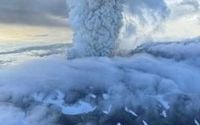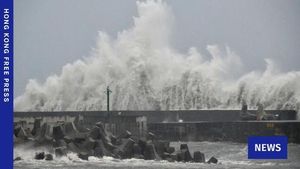The Krasheninnikov volcano on Russia’s Kamchatka Peninsula erupted with renewed force on August 11, 2025, sending a towering ash plume nine kilometers into the sky and triggering a red aviation alert across the region. This marks the volcano’s first eruption in centuries, an event that has intensified following a significant earthquake that struck the peninsula on July 30, 2025.
Why it matters:
The eruption’s scale and intensity pose immediate risks to both local communities and international air traffic. The red aviation color code, the highest alert level, signals a direct threat to aviation safety, with ash clouds capable of damaging aircraft engines and disrupting flight paths across the northern Pacific. The Krasheninnikov volcano’s activity is part of a broader surge in global volcanic eruptions, with simultaneous events reported in Indonesia, Japan, Ecuador, and Mexico, underscoring the interconnected nature of seismic and volcanic hazards worldwide.
Driving the news:
- At 6:00 a.m. GMT on August 11, 2025, explosions from Krasheninnikov sent ash up to 9,000 meters (approximately 29,500 feet) high, according to the Far Eastern Branch of the Russian Academy of Sciences, as reported by TASS.
- The ash plume drifted 1,114 kilometers east from the volcano, threatening air corridors used by both domestic and international flights.
- The eruption began after a major earthquake struck the Kamchatka Peninsula on July 30, 2025, and has intensified in the days since, with additional ash emissions recorded on August 5 and August 8.
- On August 5, the volcano sent an ash plume eight kilometers into the sky, and on August 8, it spewed ash twice.
- The Krasheninnikov volcano is part of the Klyuchevskaya Sopka stratovolcano complex, which is Eurasia’s tallest active volcano.
- Authorities have declared a red aviation color code for the region, warning pilots and airlines of the heightened danger.
State of play:
- Explosive volcanic activity is ongoing at Krasheninnikov, with the Volcanic Ash Advisory Center (VAAC) in Tokyo issuing advisories for ash plumes reaching up to 10,000 feet (3,000 meters) on August 10, 2025, moving east at 15 knots.
- Klyuchevskoy volcano, also in Kamchatka, continues to emit ash plumes, with VAAC Tokyo reporting emissions up to 36,000 feet (11,000 meters) on August 10, moving in the same direction.
- The region’s volcanic activity has led to the assignment of the highest aviation hazard code for Klyuchevskoy as well, reflecting the widespread impact on air travel.
- The Krasheninnikov volcano features a cone shape, a 700-meter-wide caldera, and approximately 80 lateral explosive craters and cinder cones on its slopes, making it a complex and potentially unpredictable system.
By the numbers:
- 9 kilometers (9,000 meters): Height of the Krasheninnikov ash plume on August 11, 2025.
- 1,114 kilometers: Distance the ash plume traveled east from the volcano.
- 8 kilometers: Height of the ash plume on August 5, 2025.
- 700 meters: Width of the volcano’s caldera.
- 80: Number of lateral explosive craters and cinder cones on Krasheninnikov’s slopes.
- 10,000 feet (3,000 meters): Ash plume altitude reported by VAAC Tokyo on August 10, 2025.
- 36,000 feet (11,000 meters): Ash plume altitude from Klyuchevskoy volcano on August 10, 2025.
Zoom in:
- The eruption’s timing—following a major earthquake—has drawn attention from seismologists and volcanologists, who are monitoring for further seismic activity that could influence the volcano’s behavior.
- Satellite imagery from August 10 shows the extent of the ash cloud and the ongoing explosive activity, not only at Krasheninnikov but at other volcanoes in the Pacific Ring of Fire.
- Other volcanoes currently erupting worldwide include Popocatépetl in Mexico, Semeru and Ibu in Indonesia, and Nevado del Ruiz in Colombia, each issuing their own ash advisories and affecting local populations and airspace.
What they’re saying:
- “Explosions at 6:00 a.m. GMT sent ash from the volcano up to 9,000 meters. The ash plume drifted 1,114 kilometers east from the volcano,” the Far Eastern Branch of the Russian Academy of Sciences said in an official statement, as reported by TASS.
Between the lines:
- The assignment of the red aviation color code is a critical measure for ensuring the safety of air travel, as volcanic ash can cause catastrophic engine failure and reduce visibility for pilots.
- Kamchatka’s position along the Pacific Ring of Fire makes it one of the world’s most volcanically active regions, with frequent eruptions posing ongoing challenges for disaster preparedness and response.
- The current eruption is the first for Krasheninnikov since the 16th century, highlighting the unpredictable nature of dormant volcanoes and the importance of continuous monitoring.
How it works:
- When a volcano erupts, explosions can eject ash, gas, and volcanic rock high into the atmosphere, where strong winds can carry the material over great distances.
- Aviation color codes are used internationally to alert pilots and air traffic controllers to volcanic hazards, with red indicating an eruption is imminent or ongoing with significant emission of ash into the atmosphere.
- Seismological data, satellite imagery, and direct observations are combined to track the evolution of eruptions and inform advisories.
What to watch:
- The ongoing seismic and volcanic activity in Kamchatka will be closely monitored for further escalation, as additional eruptions could impact broader swathes of airspace and potentially disrupt trans-Pacific flights.
- Scientists are also watching for signs that other dormant volcanoes in the region could awaken in response to shifting tectonic forces, a phenomenon observed in other volcanic hotspots around the globe.
The bottom line:
The Krasheninnikov volcano’s dramatic eruption is a stark reminder of the powerful geological forces at play beneath the Earth’s surface, with immediate consequences for air travel, local communities, and the global scientific community. As authorities maintain the highest alert and advisories remain in effect, the world’s eyes are on Kamchatka, waiting to see what the volcano will do next.





